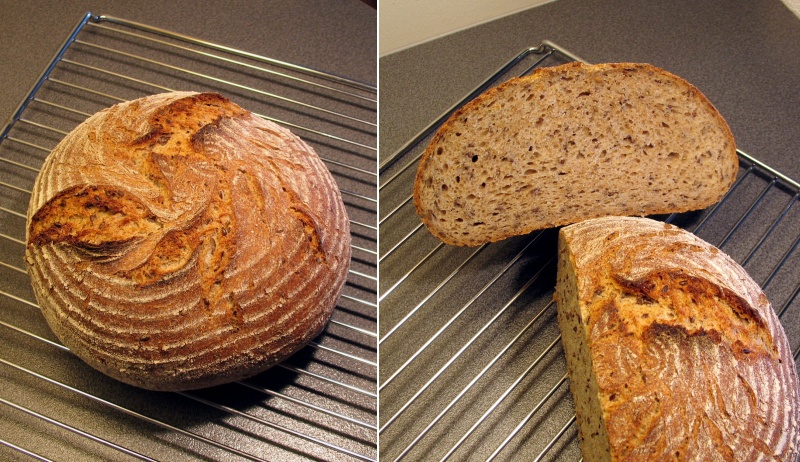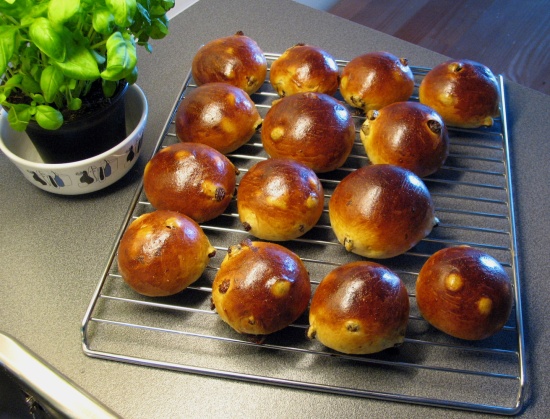April 11, 2010 - 6:18am

Signs of spring (at long last)
Better late than never, right?
I've been out of the loop for a little while, but I've still been baking. This week I have slowly worked my way through the flaxseed rye shown below, based on Hamelman's flaxseed rye from Modern Baking (link here to recipe here). I prefer to bake it as a pure sourdough, so the final proof is extended by approx. 50% compared to the original recipe. I've savoured the loaf with slices of brie, smoked ham or fish.

On Friday, I spotted some of the season's first strawberries at my local market, and I simply couldn't resist:

Delicious early-spring treat! ...and would you believe it? The snow's almost all gone here now! :D (<-- happy grin)
Raisin buns is a perfect snack to pack along for upcoming hikes:



Comments
You've been missed, Hans. After looking at your photos, I suspect your absence was because you were completing your advanced degree at an internationally acclaimed baking and pastry institute.
The bread and rolls are beautiful; your cake is exquisite. You are no "amateur" baker by any means.
Gorgeous pastries and breads, Hans. Always such a delight to see your baking! Strawberries are here : ) ... what a delicious way to celebrate.
Sylvia
The more I see pictures of loaves that have been allowed to develop their own fissures vs. slashing, the more I'm taken by their natural beauty.
Larry
David
Wow! I feel hungry even though I just ate! Amazing looking bakes-really great work!
Christina
hj
It worth confessing, when i feel accomplished in baking, i almost always go back to your blog to boost my persuit of perfection, not that i'll get there anytime soon..
I believe that the testimony of Chef Hammelman by praising your version of his breads is alone a success.
Thumbs up,
The cake is to die for!
You show such panache with your cakes! Truly, many pros would battle to attain your standard of presentation.
As for the bread - glorious! Do you really not slash at all? What's the thinking behind this? Slashing is something I've always done unquestioningly, but I noticed recently that an acclaimed sourdough bakery here doesn't slash, either. Their loaves were far more rustic-looking than yours, though.
Cheers
Ross
Thanks so much for the kind words, Mebake, arlo and Ross! They're highly appreciated!
@ Ross: I usually don't slash the breads that are heavy on rye. Instead, I bake them seam-side up, so there are weak points in the dough that allow the loaf to expand once it's in the oven. When there's lots of rye in the dough, the surface becomes fragile and tear easily - that's why the seams are very likely to open up during oven spring. The "random" or "natural"/"explosive" appearance is something I find much more attractive in these dense breads compared to usual slashes.
Hans, your breads always look fantastic, but your desserts are works of art. Love that you always include one---thank you for sharing!
What more does one really need?
Wonderful looking rye you've got there. The crumb looks so consistent and airy it's hard to believe its 40% rye.
What type of rye flour did you use?
John
Thanks Debra and John! :)
I hope you've got more sourdough population dynamics to share with us soon, Debra :)
@ John: Thanks! I used whole-rye flour in the loaf. I feel that my whole-rye flour provides a more intense and pronounced rye character to the breads, so I prefer to use that rather than a medium rye variant. The crumb becomes slightly denser, but I'll gladly compromise to get that full-on taste experience ;)
I sat down over the weekend and tried to write the next installment, but the words just weren't coming. Today is another glorious spring day here, and so I sat out on my back porch this morning, with coffee and notebook, and managed to draft the hardest part, so looks like I may have something to post soon. This will be number 3 of 6 installments that I already have outlined, but I'm giving myself the rest of the year to finish them all :)
Getting back to your ryes, there is much to learn here. I have made the flaxseed rye once, some years ago, and clearly, didn't know what I was doing. Last week, I decided it was time to get back on the horse and try the sourdough rye with walnuts. My crumb is not as open as yours, but it wasn't gummy or anything bad, and the flavor was very nice (50% whole rye). Now I think I may have just put the loaves in the oven too soon, because I panicked when the seams started ripping apart. I like your solution of proofing seam-down instead of slashing, and I'm going to try that next time. Any other rye tips?
Hi Debra,
It's very generous of you to spend the time and energy to share this knowledge with the rest of us! You breaking the scientific papers down into digestible bite size meals, makes it so much easier to better understand the dynamics and how cultures react to their environment. I'm looking forward to your upcoming installments!
As for the ryes, I also feel that I learn something new with every bake. The procedure I've followed is basically a) reading the rye-bits in "Bread", followed by b) baking a couple of the formulas in chap. 6, and c) think about what I should do next time to improve the loaf - then return to a) and start over.
There are a couple of things I usually do different compared to Hamelman's recipes in "Bread":
1. I usually bake ryes without commercial yeast. I personally find this to give a better oven spring and better aerated crumb. This works great for most of his formulas, but you've got to experiment a bit on how fermentation times should be modified. For roughly 50% ryes, I use 1 hr bulk followed by approx. 1 hr 30 mins proof. The proof is shorter for higher % of rye in the overall formula.
2. Increase overall hydration. This point is really flour dependent, so it takes some trial and error to get it right. As a starting point, I feel that approx. 73% - 75% overall hydration is right for a 40% - 60% rye. It should be slightly sticky. I've found an increased hydration to open up the crumb as well.
3. I reduce the amount of prefermented rye of all the formulas in "Bread". I've found that by reducing the amount of prefermented flour, the dough gets less sticky and easier to work with, and that it improves the crumb. For a given rye:wheat dough, I tend to use the guidelines for prefermented flour given in the table below (taken from the textbook by Schünemann and Treu):
As I said, I'm still trying to figure all these things out myself, so I might change my mind on one or more of the above points in some weeks' time; for now, however, I feel those three modifications result in better bakes for my starter, my flour, my technique, my taste etc. ;)
Best of luck, and I hope to read about your rye bakes soon, Debra :)
Great information Hans, thank you! I'm still struggling with how much extra time to allow, because my starter seems to have an extra hour lag time in the bulk fermentation than Jeffrey's, once salt is added and the dough is made... even though my starter usually ripens well in less time than stated in the formulas. It took me several run-throughs to figure out the pattern and rethink my fermentation times. With formulas that add yeast, I don't know yet how much time to adjust for that. But, I have read in more than one paper that "process parameters may need to be optimized on a starter by starter basis." So you are doing right to modify and readjust as results indicate. I too, usually find that less is more when it comes to (naturally) prefermented flour.
And, I'm sure I need to increase the hydration. My dough was very firm even though I added three generous splashes in addition to the water specified in the formula. I've come to the conclusion that I just need to start with 5% more water up front, and adjust from there. All my flours have been soaking up more water lately. I don't know why---the air must be less humid around here than normal.
Thank you for these valuable tips, Hans. I hope to give it another go very soon. Will let you know how it goes : )
My last go at the rye with walnuts (and currants) came out better all the way around. I did increase the water, but saw the biggest improvement just from proofing seam down.
The loaf on the left was proofed seam side up. The seam separated well before the end of the proof, and when I turned it out, it spread more because it lacked the support of a tighter surface.
The one on the right was proofed seam down in the basket, which held the seam together beautifully. It was fused so well in the end, that I could barely see it, and the loaf stayed more compact after turning it out. With the greater surface tension, the expansion came more through the slash.
Both loaves overall had the same volume and crumb, but the right loaf, proofed seam down, was taller and more attractive.
Thank you Hans!
Debbie
They both look brilliant - but I agree that the right one has an edge over the other :)
Do they taste and smell as great as they look? Thanks for posting, Debbie!
They did taste great. Not as open as yours, but maybe that's unrealistic with all the walnuts and currants in there. Very good with goat cheese or cream cheese, and much healthier than a bagel. I was very pleased with this bread. I sent most of it to work with my husband, and he said it disappeared : )
I have a question regarding your non-scoring of breads with over 50% rye percentage.
I love baking rye breads and actually never score them but always dock them....so I am curious to know if you also refrain from docking them or if you only refrain from scoring them?
I am also interested in your comment about using less pre-fermented flour than what Hamelman suggests-you said "I've found that by reducing the amount of prefermented flour, the dough gets less sticky and easier to work with, and that it improves the crumb."
Would you care to elaborate? I am so used to rye dough being sticky that I don't know how to imagine a rye dough being easier to handle.And by crumb improvements do you mean that it is looser,less dense?
I am just terribly curious about your experiences and deductions and am hoping you are willing to share in more detail.
Christina
Great questions, Christina!
Apart from whole-grain rye breads that I bake in baking tins, I usually don't dock. I'm not sure why - I guess I prefer either slashing or letting the cuts open by themselves visually.
When it comes to the question of prefermented flour, I don't think I'm able to offer any proper explanation to what I'm experiencing. I just feel that, when the amount of prefermented flour is adjusted according to the table above, it seems that the dough has better strength and is easier to preshape and shape compared to a dough with more prefermented flour. I would initially think that more rye sourdough should lower the dough pH and thus strengthen the gluten properties, but the picture is usually not that simple... I guess you just have to experiment and see what works best for you.
And yes, by improved crumb, I meant that it's more open, with better aeration. I also think I'm getting a better oven spring now than I used to, but that could be due to a more vigorous rye starter or shaping techniques etc.
I'm sorry that I can't offer any more "rigorous" answers to your questions, Christina!
Thanks for answering my "rigorous" questions, Hans(or should I adress you as Hansjoakim?)!
Your answers are quite enlightening......I will try the non-docking,seam up method the next time I bake a rye mix bread-maybe even a 100% rye....I just made the Hamelman 90% rye and it was free-formed( I really need to google translations for some of these baking terms I only know in German), docked and could have used a wee bit more strength(the final fermentation happened on a sheet pan not a brotform-surely a brotform/bowl would make a difference)
I have not had any complaints myself about crumb aeration, but if gluten properties can be strengthened by less pre-fermented flour that will definitely be worth a try for me.
Thanks so much for your thorough answers!
Christina